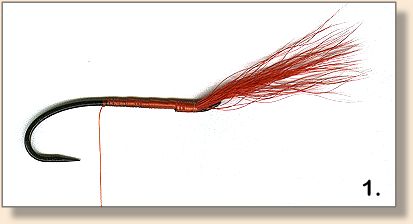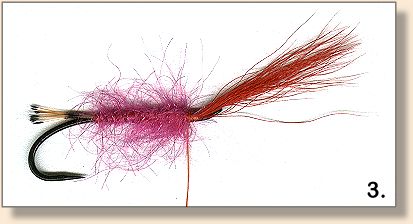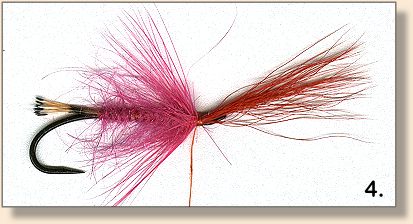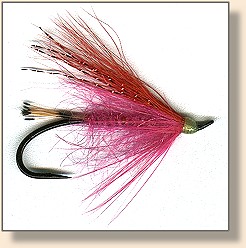|
It seemed like it was about time.
My 3-year-old has loved fish and fishing since he was old
enough to focus his eyes on the Fly Tyer and
American Angler magazines read to him before
bedtime. Trips to the Eureka Fly Shop and the Mad River are
true highlights for him. All this in only 45 lbs. of boy.
Yesterday he was a little wound up and getting in the grill
of his little brother, so he came back to my study for a
settle-down session. As children of his age are wont to do,
he began pouring forth the questions:
"What kind of fly is that, dad?"
"Why is that fly black?"
"Why don't we touch hooks?"
"Did you catch the fish in that picture?"
Then the one that got my attention, "When I'm bigger, can I tie flies?"
He's been sitting on my lap at this desk since the week he was
born, but all of the sudden the last time I remember him being
here, he could be laid across one arm with room to spare. He
has really grown!
"JM, I think you are bigger!"
He grins in a funny way, and I don't think he was too terribly
surprised when I grabbed a #6 wet fly hook, pinched the barb,
and dulled the point. The bare hook was placed deep in the
vise to protect little fingers, and the materials selection
began. Slowly, the selection of fuzzes and fibres made their
way onto the steel aided only by his struggles with the 3/0
Unithread and some scissor snips from dad. He did all the
pinching and wrapping by himself. Each element took a couple
tries, but determined as he was, within a few minutes I slipped
a half-hitch over the eye, and he had tied his very first fly.
The questioning mind prompts the smiling mouth to bring forth
yet another query, "Daddy, will this catch Stee'heads?"

Now, to be sure this particular fly will never see water,
but his child's creative eye doubtless envisioned the pattern
tempting finny creatures. Not surprisingly, then, he picked
the brightest materials offered him, but they came out in
co÷rdination. With a GP tippet tail, magenta chenille body,
red bucktail wing, and chartreuse head, it might be garish,
but then again, most of the flies we use for Pacific Salmon
are! His question must still be answered, though!
The test of effectiveness was one of necessity, then. This
was - and is - his fly, and my heart would no doubt swell
even if it was functionally useless. One way or the other,
it just looked so effective, I had to get some in the drink
to see what happened. The fly was copied with minor
modifications and passed out for use on the Mad, Dean,
Skeena, Skagit, Trinity, and other Salmon/Steelhead rivers
across the Pacific Northwest. In it's brief existence, the
fly has landed Kings, Silvers, Steelhead, and Sea-Run Cutthroat.
I'm sure that it will take other Salmon under the proper
conditions as well, and I can only hope to give each of them
their opportunity to prove the lasting work of the pattern.
Good job, JM! =)
Materials List (Adult version):
Hook: Dai-Riki 899, #2/0-#6.
Thread: Red 3/0 Unithread.
Tail: Golden Pheasant Tippet.
Body: Magenta SLF.
Wing: Red hair and red Krystal Flash .
Hackle: Magenta.
Head: Chartreuse.
Tying Instructions:

1. Tie in red wing hair facing forward. When you bend
it backwards, the tips should be even with the bend of
the hook. Although I used bucktail here, if I had calftail,
kid goat, Finn raccoon or arctic fox in this colour, I would
have used it. This is the only red I have, though.

2. Wind thread to the rear of the hook, and tie in a bunch
of Golden Pheasant tippet strands. The tie-in point should
be directly above the hook pont, and it should extend evenly
with the hook bend. (The wing, tail, and bend should be in
the same line. See final picture for reference.)

3. If you want to use chennille, tie it in here, and wind
it up. SLF's "magenta" is used here, although there are
other good products as well. The dubb is placed in a loop
and wound forward toward the wing. Since I have used a
larger-than-practical thread for photographic purposes,
I used the split-thread technique here. It has advantages
in that it makes a minimal amount of dubb fill up a fly body
very effectively. The shaggier, the better... make a little
material look like a lot!

4. Tie in a magenta hackle by its tip, fold it, and wind
a sparse collar. JM is a bit too young for winding hackle,
but the pattern seems to call for it.

5. A few strands of red Krystal Flash are tied in before
the wing is folded, then the entire wing assembly is pointed
rearward and wrapped in place. The head is chartreuse,
although that's probably irrelevant.
JM's original version features materials as follows:
Hook: Dai-Riki 070, #6.
Thread: Red 3/0 Unithread.
Tail: Golden Pheasant Tippet.
Body: Magenta Chennille.
Wing: Red bucktail.
Head: Chartreuse.
~ Thomas C. Duncan, Sr.
|



